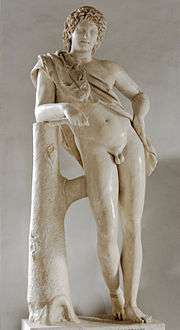Resting Satyr

The Resting Satyr or Leaning Satyr, also known as the Satyr anapauomenos (in ancient Greek ἀναπαυόμενος, from ἀναπαύω / anapaúô, to rest) is a statue type generally attributed to the ancient Greek sculptor Praxiteles. 115 examples of the type are known, of which the best known is in the Capitoline Museums.
Description
It shows a young satyr, identifiable from his clearly pointed ears and the pardalide (panther pelt) worn across his torso. He rests his right elbow on a tree trunk, in an unstable position, supported only on his left leg. His right leg is bent, with his right foot just touching his left heel. In a number of examples a restorer has added an attribute held in his right hand, often a flute or Pan pipes, while the left hand is on the left hip holding down the pelt. The facial features are well defined and the nose slightly upturned. His heavy hair, recalling the iconography of river gods, is held by a cord or a crown.
Attribution
The Resting Satyr is traditionally identified as the "satyr periboêtos" mentioned by Pliny the Elder in his Natural History XXXIV, 69:
- "[Praxiteles produced in bronze] a Liber Pater, and a famous Drunkard, and a satyr that the Greeks call periboêtos
- (et Liberum patrum Ebriatem nobilemque una satyrum quem Græci periboeton cognominant)
Since Winckelmann this word has traditionally been translated as "famous".[1] This celebrity explains the large number of examples of this type, one of the most popular in the Mediterranean - just under 115 have been found, including 15 from Rome, 4 from North Africa, 8 from Greece, two from Spain and one from Gaul.[2]
List of other known ancient copies
- Resting Satyr. Roman artwork sculpted in marble between 150 and 175 CE, in Prado Museum, Spain.
- Resting Satyr. Roman copy after the mid-4th century B.C, marble, height 168 cm, in Hermitage Museum, Russia.
- Resting Satyr (Satyrus anapauomenos). Roman copy of the 2nd century CE, in Hermitage Museum, Russia. Inv. No. Гр. 3058 / A.154.
- Resting Satyr, 2nd century AD, Royal Castle, Warsaw, Poland.
- Resting Satyr, Roman copy of the 2nd century, marble, height 180 cm, in Ny Carlsberg Glyptotek, Copenhagen, Denmark. Inv. No. 474.
- Resting Satyr, Roman copy, first half of the 2nd cent. Carrara marble, height (without pedestal) 1.78 m, width of the statue 0.76 m, height of the pedestal 0.08 m., Santa Maria Capua Vetere, Archaeological Museum of ancient Capua, Italy.
Examples
 Ruspoli Faun, Munich Glyptothek (inv. 228)
Ruspoli Faun, Munich Glyptothek (inv. 228) Ruspoli Faun, Munich Glyptothek (inv. 229)
Ruspoli Faun, Munich Glyptothek (inv. 229) Farnese Faun, Louvre (Ma 664)
Farnese Faun, Louvre (Ma 664)_01a.jpg) Resting Satyr, Prado Museum
Resting Satyr, Prado Museum Resting Satyr, Hermitage Museum
Resting Satyr, Hermitage Museum Leaning Satyr, Hermitage Museum
Leaning Satyr, Hermitage Museum Resting Satyr, 2nd century AD, Royal Castle, Warsaw, Poland
Resting Satyr, 2nd century AD, Royal Castle, Warsaw, Poland Satyr Anapauomenos, Centrale Montemartin, Capitoline Museums, Italy
Satyr Anapauomenos, Centrale Montemartin, Capitoline Museums, Italy
Notes
- ↑ "The whole world talks of his Satyr, object of innumerable praises (περιϐόητος)." - History of the Art of Antiquity
- ↑ Bartman, p. 54.
Bibliography
| Wikimedia Commons has media related to Leaning satyr. |
- Elisabeth Bartman, Ancient Sculptural Copies in Miniature, Columbia Studies in the Classical Tradition, vol. 19, Brill, Leyde, New York and Cologne, 1992 ISBN 978-90-04-09532-8.
- Francis Haskell and Nicholas Penny, Taste and the Antique, Yale University Press, New Haven and London, 1981, p36.
- (French) Jean-Luc Martinez, "Les satyres de Praxitèle", in Praxitèle, Louvre exhibition catalogue, éditions du Louvre & Somogy, 2007, ISBN 978-2-35031-111-1, p. 236-291.
- Brunilde Sismondo Ridgway, Fourth-Century Styles in Greek Sculpture, University of Wisconsin Press, Madison, 1997 (ISBN 0-299-15470-X), p. 265-267.
- (German) Barbara Vierneisel-Schlörb, Glyptothek München. Katalog der Skulpturen, p32, p. 353-369.